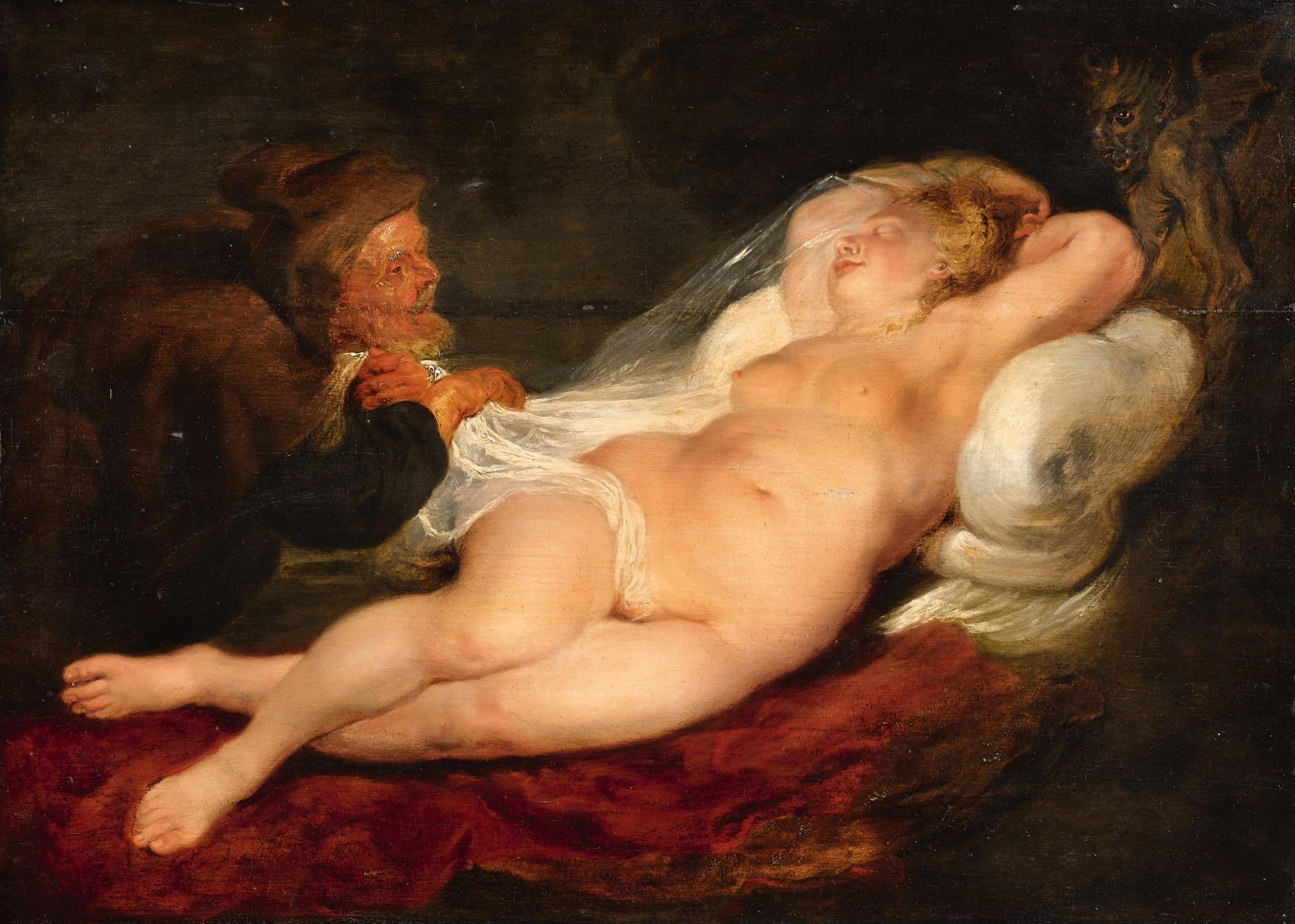Peter Paul Rubens, studio of
Angelica and the Hermit
Oil on panel. 45.7 x 63 cm.
This motif of the hermit and the sleeping Angelica is a rarely depicted scene from Ariost's “Orlando Furioso” and is a workshop replica of a composition which Rubens painted between 1626 and 1628. Scholars agree that the painting is a replica made in Ruben's workshop, and Fiona Healey (exhib. cat. Antwerp 2004, op. cit.) even postulates this to be the work known to be in the master's collection upon his death in 1640 which was purchased by his son Nicolaas Rubens during the auction of his father's collection.
The work depicts a scene from the eighth canto of Aristo's epic poem (canto VIII, 29-50). The hermit, who is hopelessly in love with the beautiful Chinese princess Angelica from the court of Charlemagne, follows her and enchants her horse so that it carries her to a deserted island. Here the hermit wishes to win the young girl's heart by playing the part of her rescuer. Once on the island, the hermit comforts Angelica, but she rebukes him when his attentions become inappropriate, upon which he puts her to sleep with a magic potion. The hermit then attempts to ravish the defenceless princess, but is prevented by his failure to perform, a plot point which Ariost describes at length throughout several verses. The hermit eventually falls asleep beside Angelica. Rubens has depicted the moment in which the princess is put to sleep by the potion, allowing the hermit to approach and avail her of the white cloth that covers her body. Ariost describes how the hermit kisses her breast and mouth (“Or le bacia il bel petto, ora la bocca”). Rubens transformed Ariost's story into a finely painted work, contrasting the bright, warm tones of the female nude with the dark, pastose pigments of the hermit's skin - and this same quality is evident in the present copy.
Two other versions of this composition are known to have been painted by Rubens himself. It is thought that the piece sent along with other works to the Duke of Buckingham George Villiers in England in 1626 was the prime version. The Buckingham version is probably identical to a work which was known to have been kept in the collection of Charles Emile Janssen in Brussels in 1931, the whereabouts of which is currently unknown. A version painted by Rubens himself which today hangs in the Kunsthistorisches Museum in Vienna (inv. no. GG 692) displays a similar composition and dimensions to the present work. As previously mentioned, Fiona Healey has suggested that this work could be the piece purchased by Rubens' son Nicolaas upon the artist's death, as his collection is known to have included a work depicting the hermit and the sleeping Angelica.
Certificate
Prof. Dr. Hans Gerhard Evers, Darmstadt, 12.7.1971 (attributed to Peter Paul Rubens).
Provenance
Possibly the estate of Peter Paul Rubens, Antwerp 1640. – Possibly Nicolaas Rubens, Antwerp. – Anthony Royre, London, 1927. – The Sperling Collection, 1928. – O. Wargand, Saarbrücken, 1930. – Galerie Buck, Mannheim, 1930. – Actuarius, Zurich, 1931. – Galerie Heinemann, Munich, 1938. – Private collection, Germany. – Adfintrust Holding B.V. - Private collection, Hesse. - 895th Lempertz auction, Cologne, 17.11.2006, lot 1134. - Private collection, Europe.
Literature
Jeffrey M. Muller: Rubens: The Artist as Collector. Princeton 1989, p. 117. – Exhib. cat. Antwerp 2004: A House of Art. Rubens as Collector. Ed. by Kristin Lohse Belkin & Fiona Healey. Schoten 2004, p. 126-128, no. 13 (catalogue entry Fiona Healey).
Exhibitions
Rubens as Collector, Rubenshuis, Antwerp 2004, no. 13.

